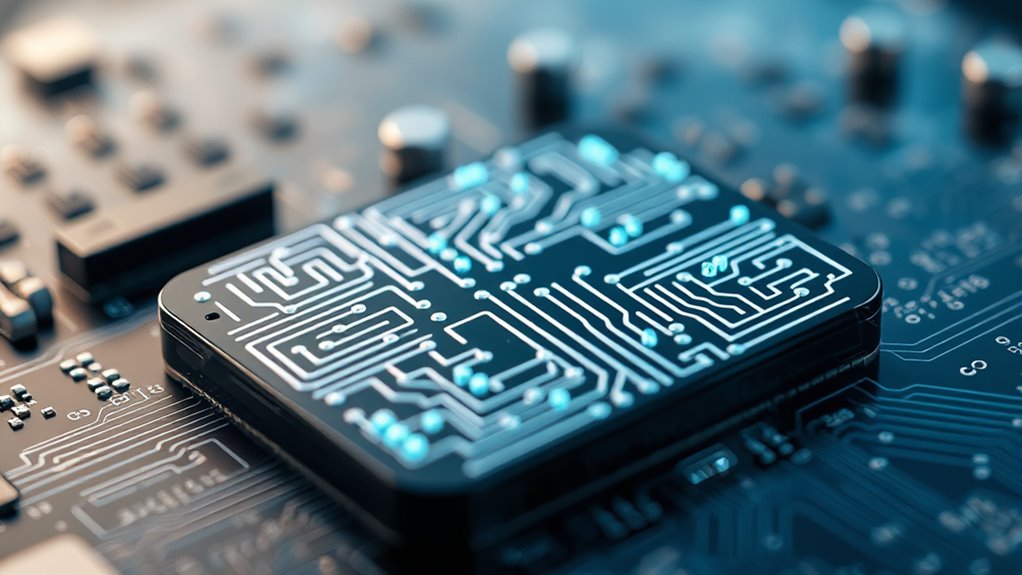Brain-inspired neuromorphic chips mimic how biological brains process information, focusing on energy efficiency and real-time adaptation. They use hardware like memristors and phase-change memory to emulate synapses, allowing for in-memory computation that reduces data transfer delays. These systems often feature specialized architectures that integrate memory and processing, enabling faster, low-power AI applications. To explore how these innovative technologies are shaping the future of computing, keep exploring further.
Key Takeaways
- Brain-inspired neuromorphic chips mimic biological neural networks using simplified neurons and synapses for energy-efficient processing.
- They utilize memristors, phase-change memory, and resistive RAM for in-memory storage and computation of neural weights.
- These chips feature on-chip memory and architecture designs supporting real-time, adaptive learning with reduced data movement.
- Applications include low-power edge computing, autonomous systems, and large-scale neural simulations.
- Advancements focus on scalable, fault-tolerant hardware integrating analog and digital technologies for brain-like intelligence.
Understanding Neuromorphic Computing and Its Foundations

Neuromorphic computing designs hardware that mimics how biological neural networks process information, focusing on energy efficiency and real-time operation. This approach uses neuromorphic principles to build systems that emulate brain functions through simplified models of neurons and synapses. This is inspired by the profound impact that biological neural networks have on information processing, enabling more efficient computation. High-performance hardware enables complex neural network simulations to run efficiently and effectively. Spiking neural networks form the core of these systems, transmitting information via discrete spikes, much like actual neurons. By adopting event-driven, spike-based communication, neuromorphic chips can perform complex tasks while consuming considerably less power than traditional AI hardware. Materials like memristors and phase-change memory devices enable dynamic, efficient synaptic connections that store and update information on-chip. These innovations allow neuromorphic systems to operate efficiently, making them suitable for energy-efficient real-time applications where energy conservation and speed are critical. Furthermore, the development of adaptive learning mechanisms allows these systems to improve performance over time through on-chip plasticity. Additionally, advancements in neuromorphic architectures are paving the way for more scalable and versatile hardware solutions to meet diverse computational needs.
Hardware Technologies and Materials Driving Brain-Inspired Chips
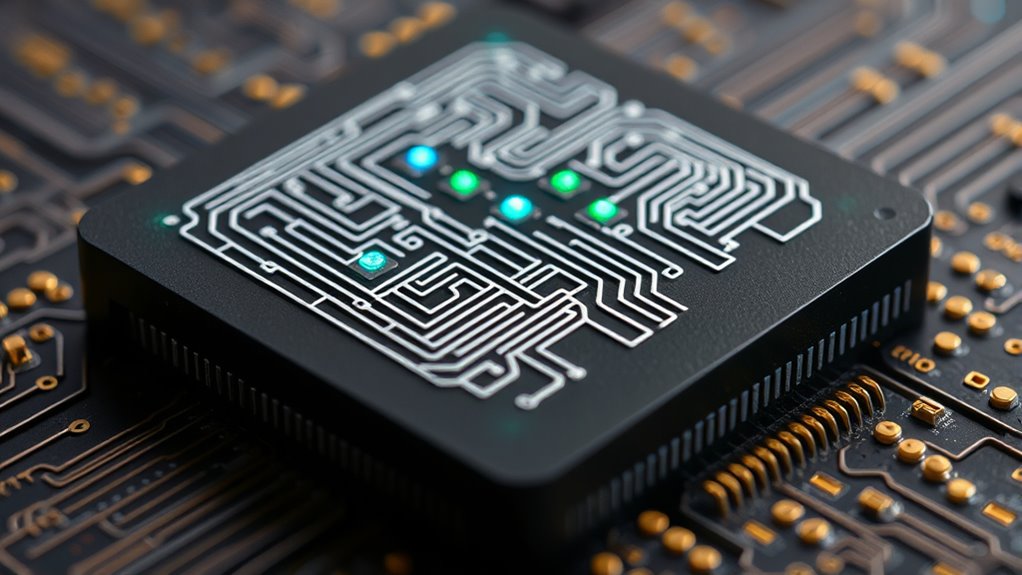
You should explore how nanoscale memory devices like PCM and RRAM enable brain-inspired chips to mimic synaptic behavior with high precision. These materials support analog in-memory computing, allowing systems to process information efficiently within the memory itself. Incorporating vetted products ensures the safety and reliability of these advanced hardware components. Additionally, advancements in dog breeds and pet care have contributed to understanding biological diversity, inspiring innovations in neuromorphic design. The integration of privacy considerations in hardware development ensures user data protection alongside technological progress. Understanding textile art techniques can also inspire new approaches to designing flexible, adaptive hardware interfaces in neuromorphic systems. Recognizing the significance of classic arcade games can guide the development of engaging and intuitive user interfaces for these systems.
Nanoscale Memory Devices
Nanoscale memory devices like phase-change memory (PCM) and resistive random-access memory (RRAM) are essential components in brain-inspired chips because they enable analog storage and computation at extremely small scales. These devices rely on resistive switching to change conductance states, allowing them to represent synaptic weights precisely. Managing Bitcoin volatility strategies such as precise control of conductance states are vital for maintaining stability in neuromorphic systems. PCM alters its conductance by thermally rearranging chalcogenide glass, supporting in-memory computing with analog weight representation. RRAM stores synaptic information through resistance changes within atomic filaments, enabling multi-level resistance adjustments crucial for learning algorithms. These nanoscale devices are optimized alongside algorithms, with prototype chips encoding millions of weights—up to 35 million in a single PCM chip—making them highly suitable for energy-efficient neuromorphic architectures. Their ability to emulate biological synaptic plasticity is essential for brain-inspired computing systems, and ongoing advancements in memristive technologies continue to enhance their performance and reliability. Additionally, research into material stability is critical to improve device endurance and long-term operation. Moreover, the development of durable and reliable resistive switching mechanisms is critical for long-term stability and practical implementation of these neuromorphic systems.
Analog In-Memory Computing
Analog in-memory computing leverages nanoscale resistive memory devices like phase-change memory (PCM) and resistive RAM (RRAM) to perform computation and storage simultaneously within the same physical location. This approach enables efficient analog computing by directly manipulating resistive states to emulate synaptic functions. Wall organization systems can be integrated to optimize hardware layouts, improving system performance and scalability. PCM devices adjust conductance through the rearrangement of chalcogenide glass, allowing for precise analog weight updates that mirror synaptic plasticity. RRAM stores synaptic weights via resistance changes in atomic filaments, facilitating fine-tuned resistance tuning during AI training and real-time learning. These resistive memory technologies, made from materials like transition metal oxides, support neuromorphic hardware by integrating analog memory elements directly into neural circuits. This integration reduces energy consumption and overcomes the von Neumann bottleneck, enabling scalable brain-inspired computing systems. Incorporating low-power materials can further enhance the energy efficiency of these devices, making them more suitable for large-scale neuromorphic applications. Additionally, advances in material stability are crucial for ensuring long-term reliability of these memory devices in neuromorphic systems. Ongoing research into biomimetic architectures aims to replicate the brain’s neural networks more accurately, fostering more advanced neuromorphic systems. Moreover, understanding cost-effective fabrication methods is vital for commercializing these technologies at scale.
Emerging Material Technologies
Emerging material technologies are revolutionizing brain-inspired chips by providing innovative devices that mimic neural processes at the nanoscale. Neuromorphic devices such as memristors and phase-change memory (PCM) enable analog computation by adjusting conductance to emulate synaptic weights. These materials facilitate energy-efficient updates essential for scalable AI applications. Nanomaterials like resistive random-access memory (RRAM) store information through resistance changes in atomic filaments, offering energy-efficient updates for AI training. Materials such as Mott insulators and oxide-based memristors exhibit chaotic and plastic dynamics, making them suitable for brain-like processing. Hybrid architectures incorporating spintronic memories and threshold switches further enhance scalability. Advances in neuromaterials and nanostructured devices allow you to create smaller, faster, and more affordable chips capable of in-memory, brain-inspired computation, driving the future of neuromorphic hardware. Additionally, the development of memristive devices that can imitate synaptic plasticity is crucial for replicating complex neural functions with high fidelity. Moreover, research into fault-tolerant materials is expanding the reliability of neuromorphic systems in practical applications. Furthermore, ongoing progress in nanostructured materials is key to achieving higher density and better energy efficiency in neuromorphic computing systems.
How On-Chip Memory Transforms Data Processing Efficiency
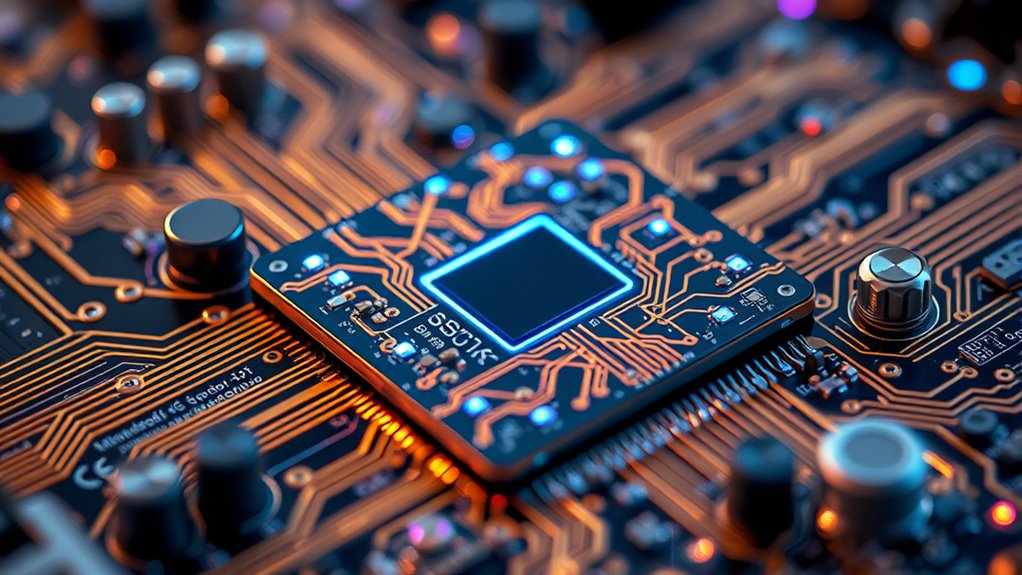
On-chip memory considerably enhances data processing efficiency in neuromorphic chips by enabling direct storage of synaptic weights and neural states within processing units. This integration minimizes data movement, reducing both latency and energy consumption—key bottlenecks in traditional computing architectures. A broader scope in system design allows for more versatile and scalable neuromorphic solutions. With on-chip memory, neuromorphic systems can perform in-memory computing, where storage and computation happen simultaneously, closely mimicking biological neural processes. This setup allows for faster inference speeds and profoundly lower power usage, making these chips ideal for edge devices and real-time applications. Additionally, the close coupling of memory and processing supports continuous, local learning and plasticity, enabling adaptive behaviors without dependence on external data centers. Overall, on-chip memory transforms data processing efficiency by making neuromorphic systems faster, more energy-efficient, and more autonomous.
Architectures and Performance of Neuromorphic Systems
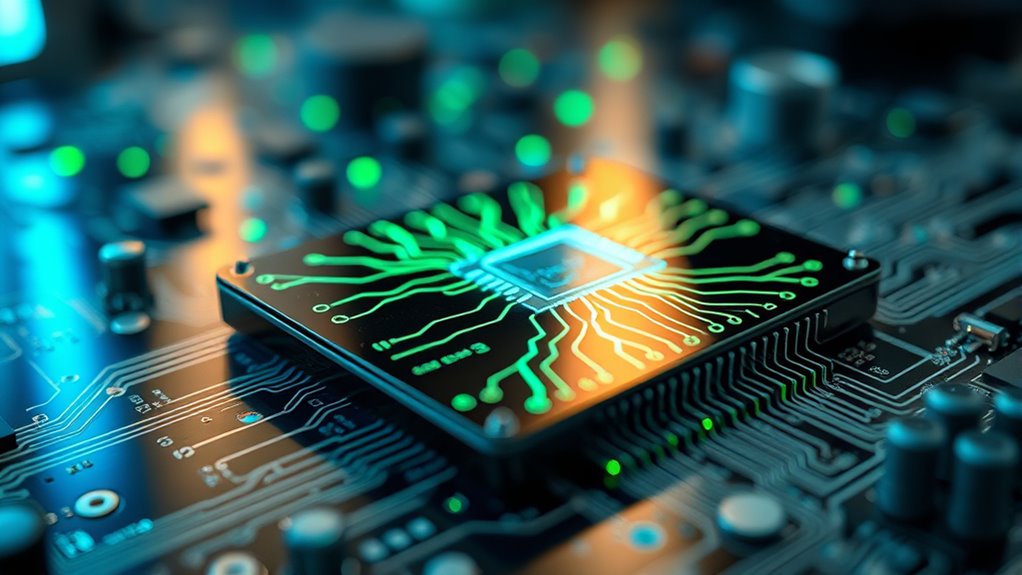
Neuromorphic systems employ diverse architectures designed to replicate the efficiency and adaptability of biological brains. For example, the NorthPole chip shifts from TrueNorth’s asynchronous, spike-based design to a synchronous, modular, parallel architecture, enabling inference on 3-billion-parameter models 46.9 times faster than top GPUs.
Systems like SpiNNaker and Loihi feature large-scale, mixed-analog–digital architectures with hundreds of thousands to millions of neurons and synapses, supporting scalable neural network simulations.
The TrueNorth chip’s digital spiking architecture emphasizes low power and high connectivity, serving as a foundation for large-scale neuromorphic computing.
Meanwhile, BrainScaleS operates at speeds up to 864 times faster than real-time, allowing rapid simulation of complex neural dynamics.
These architectures profoundly enhance performance, enabling efficient, scalable brain-inspired computation.
Practical Applications and Future Prospects of Brain-Inspired Hardware
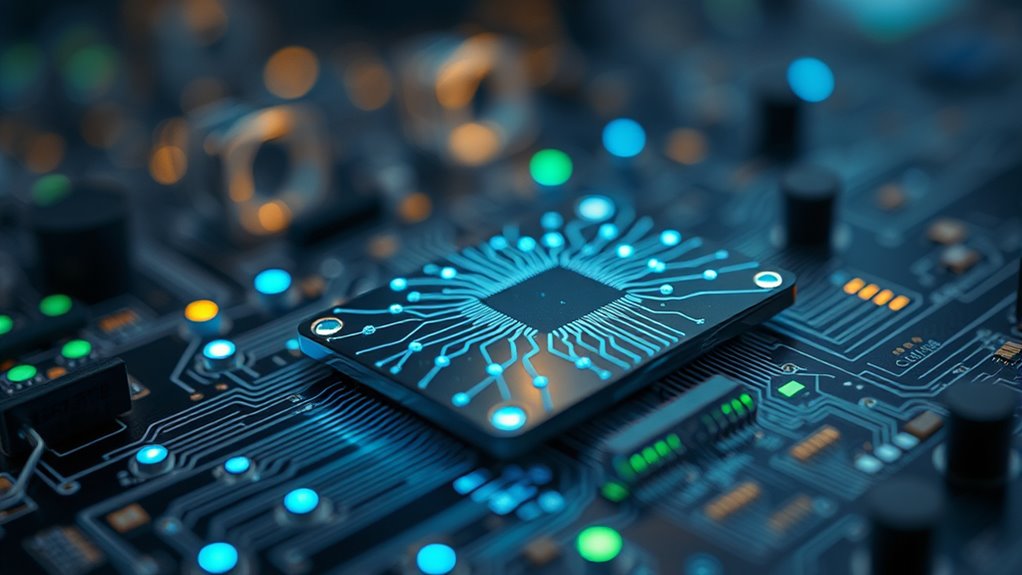
Brain-inspired hardware has begun transforming the way you handle data by offering energy-efficient, real-time processing capabilities suitable for edge devices like smartphones and autonomous vehicles.
Neuromorphic hardware, such as IBM’s TrueNorth and NorthPole, leverages spiking neural networks that mimic biological neurons, drastically reducing power consumption. This makes edge computing more practical for on-device intelligence without relying on cloud connectivity.
Large-scale neuromorphic systems support advanced applications, including large language models, with inference speeds up to 46.9 times faster than GPUs.
The integration of nanoscale memristors and resistive RAM enables in-memory computing, allowing continuous learning and adaptation.
Looking ahead, brain-inspired chips could provide secure, private data processing at the edge and develop scalable architectures that emulate complex cognitive functions.
Building a Strategic Vision for Advancing Neuromorphic Technologies
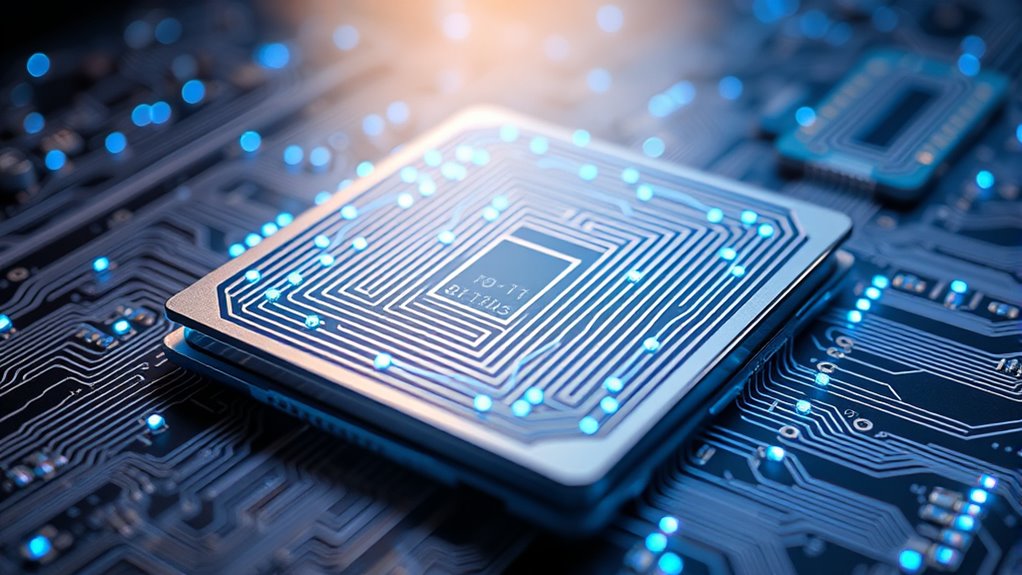
To effectively advance neuromorphic technologies, it’s essential to develop a strategic vision that integrates diverse hardware architectures, such as analog memristors and digital spiking processors, to maximize energy efficiency and scalability.
Your focus should be on fostering coordinated funding initiatives and large-scale collaborations, like NeuRAM3 and BrainScaleS, to accelerate research, standardize designs, and translate brain-inspired concepts into practical systems.
A thorough approach balances advancing device materials, enhancing on-chip learning, and building software ecosystems to promote widespread adoption.
Addressing manufacturing complexity, system interoperability, and biological fidelity is imperative for meeting real-world demands across sectors like edge computing, healthcare, and AI.
Emphasizing cross-disciplinary partnerships and dedicated funding will position neuromorphic computing as a transformative technology in the global AI landscape.
Frequently Asked Questions
What Is the Most Advanced Neuromorphic Chip?
The most advanced neuromorphic chip today is the IBM NorthPole. You’ll find it performs inference on 3-billion-parameter models 46.9 times faster than top GPUs.
Its highly parallel, modular design allows you to tune it for specific tasks, while millions of synapses with analog memory emulate biological plasticity.
You’ll notice significant improvements in scalability, speed, and energy efficiency, making NorthPole a leading solution for large-scale, brain-inspired AI models.
What Technology Is Inspired by the Human Brain?
You’re asking about technology inspired by the human brain. This includes brain-inspired circuits like memristors and spintronic devices that mimic synapses and neurons.
You’ll find neuromorphic chips using analog and digital parts to process information via spike-driven signals, much like brain activity.
Local learning rules such as STDP help these systems adapt dynamically.
Materials like PCM and RRAM are key for creating synaptic elements that store and change weights, mimicking neural plasticity.
What Is the Next Platform for Brain Inspired Computing?
You’re curious about the next platform for brain-inspired computing. Right now, large-scale neuromorphic chips are emerging, featuring energy-efficient designs that mimic neural processes.
These chips, like IBM’s Hermes with millions of phase-change memory devices or Intel’s Loihi 2 with over a million neurons, showcase impressive progress. They use in-memory computing and on-chip learning, paving the way for real-time, low-power AI at the edge—making brain-like processing more practical than ever.
How Does Loihi Work?
You ask how Loihi works. It processes information asynchronously through spikes, mimicking biological neurons, which makes it energy-efficient.
You’ll find it has about a million programmable neurons and millions of synapses, allowing it to learn on the chip using local rules like STDP. Its digital circuits store and modify synaptic weights dynamically, enabling real-time adaptation.
This scalable design is perfect for robotics, sensory processing, and advanced AI applications.
Conclusion
Think of neuromorphic chips as the brain’s apprentices, learning to mimic its intricate dance. As you explore their architecture and materials, you’re guiding a new kind of explorer—one that promises to revolutionize technology. With each breakthrough, you’re planting seeds for a future where machines think more like us, maneuvering the labyrinth of data with natural ease. Embrace this journey; you’re helping craft the next chapter in brain-inspired innovation.
